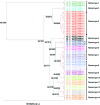Optical fingerprinting in bacterial epidemiology: Raman spectroscopy as a real-time typing method
- PMID: 19109462
- PMCID: PMC2650950
- DOI: 10.1128/JCM.01900-08
Optical fingerprinting in bacterial epidemiology: Raman spectroscopy as a real-time typing method
Abstract
Hospital-acquired infections (HAI) increase morbidity and mortality and constitute a high financial burden on health care systems. An effective weapon against HAI is early detection of potential outbreaks and sources of contamination. Such monitoring requires microbial typing with sufficient reproducibility and discriminatory power. Here, a microbial-typing method is presented, based on Raman spectroscopy. This technique provides strain-specific optical fingerprints in a few minutes instead of several hours to days, as is the case with genotyping methods. Although the method is generally applicable, we used 118 Staphylococcus aureus isolates to illustrate that the discriminatory power matches that of established genotyping techniques (numerical index of diversity [D]=0.989) and that concordance with the gold standard (pulsed-field gel electrophoresis) is high (95%). The Raman clustering of isolates was reproducible to the strain level for five independent cultures, despite the various culture times from 18 h to 24 h. Furthermore, this technique was able to classify stored (-80 degrees C) and recent isolates of a methicillin-resistant Staphylococcus aureus-colonized individual during surveillance studies and did so days earlier than established genotyping techniques did. Its high throughput and ease of use make it suitable for use in routine diagnostic laboratory settings. This will set the stage for continuous, automated, real-time epidemiological monitoring of bacterial infections in a hospital, which can then be followed by timely corrective action by infection prevention teams.
Figures




References
-
- Clancy, M., A. Graepler, M. Wilson, I. Douglas, J. Johnson, and C. S. Price. 2006. Active screening in high-risk units is an effective and cost-avoidant method to reduce the rate of methicillin-resistant Staphylococcus aureus infection in the hospital. Infect. Control Hosp. Epidemiol. 271009-1017. - PubMed
-
- Cookson, B. D., D. A. Robinson, A. B. Monk, S. Murchan, A. Deplano, R. de Ryck, M. J. Struelens, C. Scheel, V. Fussing, S. Salmenlinna, J. Vuopio-Varkila, C. Cuny, W. Witte, P. T. Tassios, N. J. Legakis, W. van Leeeuwen, A. van Belkum, A. Vindel, J. Garaizer, S. Haeggman, B. Olsson-Liljequist, U. Ransjo, M. Muller-Premru, W. Hryniewicz, A. Rossney, B. O'Connell, B. D. Short, J. Thomas, S. O'Hanlon, and M. C. Enright. 2007. Evaluation of molecular typing methods in characterizing a European collection of epidemic methicillin-resistant Staphylococcus aureus (MRSA)—the HARMONY collection. J. Clin. Microbiol. 451830-1837. - PMC - PubMed
-
- Cosgrove, S. E., Y. Qi, K. S. Kaye, S. Harbarth, A. W. Karchmer, and Y. Carmeli. 2005. The impact of methicillin resistance in Staphylococcus aureus bacteremia on patient outcomes: mortality, length of stay, and hospital charges. Infect. Control Hosp. Epidemiol. 26166-174. - PubMed
-
- Gould, I. M. 2006. Costs of hospital-acquired methicillin-resistant Staphylococcus aureus (MRSA) and its control. Int. J. Antimicrob. Agents 28379-384. - PubMed
Publication types
MeSH terms
LinkOut - more resources
Full Text Sources

